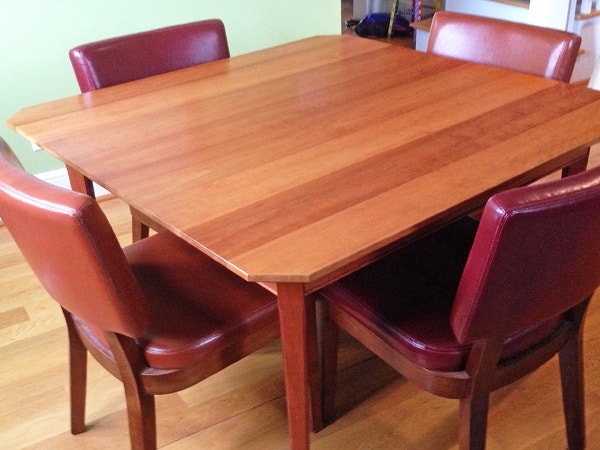How Do I Fix a Sticky Table Finish?
I inherited my parents' kitchen table after they both passed a few years ago. The table has an oak veneer top. The problem is the tabletop feels "sticky" most of the time. Not gooey where something comes off on your hand but sticky, and the more humid it is the worse it is. Newsprint from a newspaper will sometimes transfer to the top if you press the newspaper on it. I believe my mother was an avid "Pledge" user. Could this be a buildup of wax? My wife has scrubbed the tabletop with different cleaning products to no avail. Dish detergent and warm water doesn't work either. Should I try wiping the top off with alcohol, mineral spirits, acetone, naphtha, etc? If I have to refinish the top I will. Any guidance you can provide me with would be appreciated. - Gary Crofcheck
Tim Inman: Pledge, and products like it, do not add "waxy buildup" to furniture. In fact, the solvents commonly included in these products actually help wipe away a little of the "real" finish every time they are used. That dreaded "waxy buildup" phenomenon helped sell gallons and gallons of "pledge-y" products, though. It makes a great sales pitch. Who would want to be embarrassed in front of guests by "waxy buildup"? How often did your mother actually wax her tabletop? Probably not very often. So where could this wax have come from? Pledge and its ilk are not traditional waxes. They make things shine more by adding a silicon-induced gloss to the surface. They don't build up.
Your sticky problem is more than likely caused by the finish itself failing. Drying oils in the varnishes eventually destroy themselves and the sticky surface you describe is the result. Lacquers can suffer a problem caused by plasticizers migrating through the resins. One way or another, your finish surface is done. My best advice would be to suggest you clean it chemically to a surface that is not sticky. Re-stain or recolor to your satisfaction, then refinish with new material on top to give you a serviceable top.
Chris Marshall: Once the old finish is stripped and you're ready to apply a new one, I'd definitely use polyurethane. I finished our cherry kitchen table with oil-based poly nearly a decade ago. We've got two kids at home that are constantly spilling on it, dragging their laptops across it when doing homework or otherwise doing their level best to challenge the durability of that finish. On top of that, it gets wiped off repeatedly with a wet rag every day, and the finish is still going strong! When it finally wears thin, I'll strip and recoat the top with the same, or I'll use one of today's cross-linking waterbased polys instead, like General Finish's Enduro Var.
Keep the inspiration coming!
Subscribe to our newsletter for more woodworking tips and tricks




